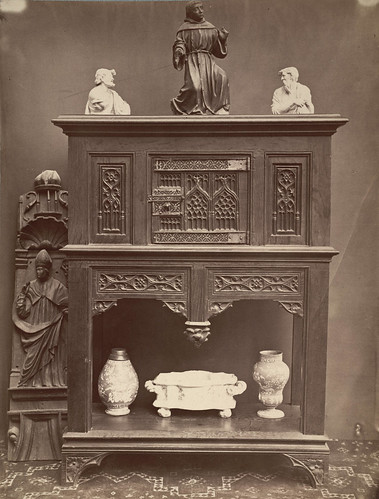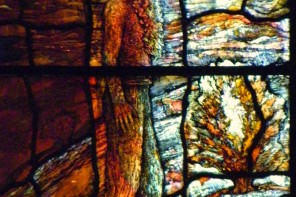~by Jenn Craft and Anna Blanch
W es Vander Lugt and James McCullough’s post on The Craft of Art and all the comments that followed inspired us to think and write about the relationship of “art” and “craft” from a slightly different perspective. It is important to note, though it seems almost rhetorical, that there are a number of different senses of the term “craft.” Like Howard Becker says,
es Vander Lugt and James McCullough’s post on The Craft of Art and all the comments that followed inspired us to think and write about the relationship of “art” and “craft” from a slightly different perspective. It is important to note, though it seems almost rhetorical, that there are a number of different senses of the term “craft.” Like Howard Becker says,
“As folk terms, ‘art’ and ‘craft’ refer to ambiguous conglomerations of organizational and stylistic traits and thus cannot be used as unequivocally as we would want to use them if they were scientific or critical concepts.”
Despite this terminological morass, it is reasonable to suggest that craft is often subsumed into the world of art or placed below it somehow. Indeed, “Craft(s)” have often been the maligned as the ugly sister of Art. Instead of quality judgments about the way in which an object or the execution of an artistic style have been realised in a work/piece, that which is made by a craftsman for a primary aim of financial gain has at times been treated with disdain by those that write about the arts, especially where the work is not easily identifiable as falling within a particularl spectrum in the tradition of the visual arts.
Yet, the skill and craftsmanship of artists who have built some of the most well-used objects in our homes, institutional buildings and churches, is no less than those of the artists that have made the pieces that often hang on their walls. But the high-low discussion is somewhat obscurative in thinking through what constitutes Art from the perspective of the craft of the Artist, no matter their materials or tradition. And regardless of any use of craft as a dismissive label to denote something less than an Art object, the time taken by an artist (of any stripe) to develop their craft – in the sense of their skills, their aesthetic eye and style – is rarely if ever wasted.
So we have craft conflated to just another, albeit slightly broader, version of art, or craft as something lesser than art. This post (in two parts) is an attempt to navigate (and possibly avoid) these two extremes that both seem to favor art. As Bruce Herman reasons in his comments to The Craft of Art article:
So much of what we’re given in art, post-WWI, shows evidence of the rupture of the two. Those inclined toward fine craft have tended to shy away from “modern art”, and those inclined toward the conceptual turn have tended to de-emphasize craft, often to an absurd degree. But what is apparent all round is the confusion — confusion over what is fitting, what is truly meaning-filled, what is beautiful and enobling.
Herman went on to suggest there that the ideas of Etienne Gilson where art is a mode of being completely side-step any discussion of definition, where the value is in the act of making before and even in primacy over any finished work. That is,
If art is a mode of being (which of course takes up techne, knowledge, language, communication, etc) then opposing or trying to evaluate the relative merits of craft vs art becomes meaningless.
In light of the abiding theories of art prevalent in modern society, however, we contend that it may be fruitful to consider a theory of craft that seeks to avoid some of the usual definitional and terminological pitfalls. That is, a theory of craft that suggests craft is something slightly different, but no less valuable, than art: a theory which also privileges the process of making as a fundamental aspect, but does not do so at the expense of the finished work. While the art/craft dichotomy is problematic in a myriad of ways, it is difficult to eschew completely a system so built into the modern mind. For this reason, a theory of craft might be just what is needed to navigate the relationship and boundaries between art and craft. In part 2 of this post (published on Friday), we’ll engage with that theory more closely and examine what craft is, what it does, and what relationship it has to our understanding of art.
Image Credit: Troyes by Gustave Lancelot (French, 1830-1906) held by Cornell University Library (used with Permission)




I would want to begin by saying how gratifying it is to have so much response to the blog that Wes and I wrote, not only in direct responses but now in a series that my colleagues here are writing. Whatever the critiques of the blogosphere that may apply and the alleged “shallows” in which it sometimes leads, the kind of dialogue and fruitful interchange that we’re seeing here is, I think, of great value.
Jenn and Anna have taken Wes and I up on the matter of the difference and/or distinction between art and craft. They advance a defense for the validity of craft on its own terms and seek to rescue it from its Cinderella status vis-à-vis “art.” I’m all for this project, and frankly look forward to their proposed definition of craft.
I believe I can speak for both Wes and I when I say that in our emerging definitional model of art, we are seeking to enhance the integrity of art by insisting on the dimension of craft. I suppose this might imply a subservient status of craft, but that is not the intention. The intention is to define art so that the “technical” aspects of a given artwork are recognized and included in whatever evaluative discussion of it ensues. We both believe strongly that where there is no technique, there is no art. And perhaps this very turn of terminology as I am using here might avoid the kind of issues Jenn and Anna raise, namely using the word “technique” rather than “craft.” But for me, craft implies a learned and honed skill (yet another synonym) passed along by some sort of “guild.” Craft also alliterates better with “content” and “context.” Hey, I want this to preach!
Let me respond now to one point in their article. Jenn and Anna write:
“Yet, the skill and craftsmanship of artists who have built some of the most well-used objects in our homes, institutional buildings and churches, is no less than those of the artists that have made the pieces that often hang on their walls.”
Now here is how I would have written that sentence in light of my own thinking about craft and art:
“Yet, the skill of craftsman who have built some of the most well-used objects in our homes, institutional buildings and churches, is no less than those of the artists that have made the pieces that often hang on their walls.”
Now I believe that sentence is true, because the people who are building these things are exercising crafts and technical skills. It was the architect, however, who in designing the buildings and churches where these things are used, employed another set of skills and craft and produced in his/her design what might be construed a work of art.
My thesis is that art transcends (but doesn’t abandon) craft when the made thing or performance is intended to communicate in a unique manner. But more on that later.
Jim,
let me first clarify (though Jim Watkins has done this somewhat for me below) that Craft is multivalent even in this post. Let me breakdown one of our sentences above to explain exactly what i mean.
“And regardless of any use of craft as a dismissive label to denote something less than an Art object, the time taken by an artist (of any stripe) to develop their craft – in the sense of their skills, their aesthetic eye and style – is rarely if ever wasted.”
In the first usage we mean a Craft object. In the second usage I mean craft in the sense of skill, craftsmanship, aesthetic eye. So the first is often tangible – it is primarily a functional object, while the second is a mixture of tangible skills and experience and intangible qualities.
In your rewriting of one of the sentences, I think it is important to understand that the line between craftsman and artist is quite blurry. In fact i think by making the change you did, you make claims about the self-identification of an artist that are not supportable. Unless of course you suggest that an artist is an artist by virtue of whether someone else thinks he/she is, rather than the individual themselves?
The post on Friday offers more discussion about “communication” in relation to Art & Craft – so i will, if i may, leave discussion of that aspect until Friday’s post is up.
Thank you for delving in to this topic. I am the Worship & Arts director for a 3-year-old church in a creative city… naturally we have lots of folks who ‘craft’ in the church. This discussion is very intriguing to me as we are working to lay a foundation that all of life is worship including the arts. We encourage all who create to worship through the arts…. often those that craft (sew, macramé, etc) are hesitant to engage our church-wide art projects… I guess that they don’t consider themselves like “artists”. We are actively working to tear down this wall and I am excited to read part II to help guide those that craft in to greater understanding of their gifts; hopefully drawing them in to deeper more meaningful worship of God through their craft. Thanks again for exploring this topic!
Miranda, thanks for taking the time to comment. I hope you will find part II of use. You may also find our week on the Domestic Arts of interest (you should find those posts by the search bar on the right hand column near the top) – where we explored through the work of guest posters, knitting, quilting, cooking/preserving, homemaking and a range of other activities. You also might be interested in knowing that we are planning another theme week about craftsmanship which will hopefully offer some additional explorations into realms usually not dealt with in theology and the arts.
Feel free to as questions and challenge us if you’d like more practical applications of what we’re writing. We walk a fine line between fairly academic content and being as accessible to as many people as possible. thanks again.
I did read the blogs on the domestic arts which was actually the reason that I subscribed to the blog. We are going to attempt something similar during the summer as our pastor preaches a worship series… should be very powerful. I am very excited to know that there is something similar in the works as well! Thank you so much for working to include the practical applications it is a great blessing to me and I am sure other Art Pastors as well. I have a fine arts degree so I am somewhat familiar with thinking about philosophies of art and enjoy reading your academic writings… but it is the practical that is most immediate and intriguing… so thank you!
I appreciate this as well, affirm what James said above, and look forward to your further articulation of the relationship between art and craft.
Is it helpful, however, to distinguish at the outset between “crafts” and “craft” as James and I articulated it, referring to the skill-and-style dimension of art?
Wes,
Thanks for your comment Wes. I tried to clarify the different sense of “craft” that we are addressing in an a comment to Jim McCullough above. However, I will say that in semiotic terms I really don’t see why the distinction is between “craft” and “crafts” – the “s” is not necessary. If i were to define them, by distinguishing them – it is “craft” as in skill and “craft” object(s) – the plural comes to define number. This is a rather esoteric argument but I think the pluralisation of craft is another (though I do not infer you meant it this way) way in which craft has been marginalised as to art. This is a really minor issue but given this is about terminology i thought it was important enough to comment.
I appreciate your concern here, Anna, and would not want to marginalise craft to art. That being said, to the extent that we are speaking of craft-as-object, does it make sense to talk about “crafts” and “the crafts” just like it makes sense to talk about “the arts.” Craft-as-skill, on the other hand is not normally pluralised, because it is a consistent element of every work of art.
Thanks, Jenn and Anna, thank you for your very thought provoking post. I am looking forward to part 2. Wes beat me to the punch with his comment, and his suggestion taht we “distinguish at the outset between ‘crafts’ and ‘craft.’ As I read Jim’s comment on this post, I became aware that there might be some confusion in the way that the various posts and comments have been using the terms ‘craft’ and ‘art’, and the sorts of things these words refer to. I noticed above that Jim uses the word ‘craft’ synonymously with ‘skill.’ In other words, he is talking about craft as a learned technique that applies to the making of an object. In Jenn and Anna’s post, however, it seems to me that ‘art’ and ‘craft’ refer to objects: or “ambiguous conglomerations of organizational and stylistic traits” of objects. It seems to me that we can talk about craft and art in reference to a process or product, but that we need to be clear what we are referring to so that there is no confusion.
As I understood Wes and Jim’s earlier post, they were thinking of the making of a work, the process involved in a work of art’s coming to be. Their argument appears to be that the making of a work of art always involves skills and techniques (which they call ‘craft’), and that presumably the making of ‘crafts’ (now in the product sense) also involves those same skills and techniques. So, a question for Wes and Jim might be: does the making of a work of art involve the same sorts of skills involved in making a craft (product)? Or are there certain skills involved in making a craft (product) that are not used in making a work of art? If the latter is true, then it would not be possible to undervalue crafts (product) or craft (process) on the basis that they involve skills that are included in, but transcended by, works of art and the making of art. In other words, perhaps there is something essential to crafts (product) and craft (process) that is not essential to works of art or the making of art. I have no idea what that ‘something’ would be, nor how to ascribe value to it, but at least you would be able to distinguish between craft and art (in both product and process senses), and also avoid the unhelpful equation: craft + something more = art.
I guess I’m coming a bit late to the discussion, but I do have a couple reflections that might be useful:
(1) A fairly simplistic distinction between ‘art’ and ‘craft’ would be that art is for aesthetic appreciation, while crafts are ‘useful.’ While this is, I think, false (or at least true only in a severely limited sense), it could provide a useful starting point for reflecting on the relationship between the two, in that it highlights the role of aesthetic theory. Jenn mentioned in commenting on the previous post the influence of the Enlightenment on shaping our modern ideas of art (with which I agree, adding only that Romantic notions of ‘inspiration’ and ‘genius’ shouldn’t be forgotten either); I wonder whether that observation could be extended into an understanding of ‘art’ and ‘craft’ as reflecting or operating in two different aesthetic systems.
To elaborate a bit further, I do think we need to accept the fact that whatever we understand as ‘art’ is largely culturally conditioned. Modern conceptions of art have stripped away some of the more technical or formal aspects previously associated with art and have focused more on the inspiration of the artist and the meaning of the work–which is why Duchamp’s ‘Fountain’ (like it or not) can be considered ‘art.’ We still retain the Enlightenment notions of art as a contemplative thing abstracted from everyday life; that too needs to be accepted. On the other hand, opposing ‘practicality’ to ‘aesthetics’ seems unhelpful: the various functionalist aesthetics of the past century would seem to disprove such a distinction, and I would imagine that most people searching for a new dining room table (for example) would not ignore aesthetic considerations in making their purchase. I don’t know enough about it to reach a conclusion, but I wonder if perhaps ‘craft’ aesthetics might reflect some of the earlier pre-Enlightenment aesthetic.
(2) I do think part of the difficulty arising in this particular discussion is the ambiguity between ‘craft’ as skill, and ‘craft’ as a sort of aesthetic more-than-just-skill. This is in play, for instance, in Jim M’s re-written sentence above: ‘the skill and craftsmanship of the artists’ in the original, ‘the skill of the craftsmen’ in Jim’s re-writing. I don’t think Jenn and Anna meant to be redundant! But I would think that ‘craft as skill’ is too narrow a definition: to speak, for instance, of a ‘well-crafted vase’ (or better yet, ‘beautifully crafted’) implies not just functionality that can be used by an artist, but a sort of aesthetic value. A vase that holds water and is strongly made can still be ugly, and thus poorly crafted.
Just to be clear, I don’t think that Jim and Wes were wrong in using the term craft to refer to ‘skill.’ Strength and skill are, etymologically speaking, the origin of the term, and the association with skill, at least, still remains within the semantic range of the term. On the other hand, I think from a linguistic standpoint it would be highly problematic to try to narrow the term to exclude the aesthetic qualities it implies, or to try to divorce the two uses from each other; and I think that any aesthetic theory that engages with ‘craft’ or ‘craftsmanship’ would be enriched from accepting the broader connotations of the term.
Well, there is quite a lot here to handle here, isn’t there?! I, like Jim M., am astounded at the response to these issues on previous posts and this one. Though Anna has clarified some of the questions put forth, I’ll put in my two-cents, too. (or would that be two-pence in Scotland?) Anyway.
I’d first like to clarify that this post is less a direct “response” to Wes and Jim’s Craft of Art post, but rather a related discussion that follows up on an issue that seemed to arise in the simple employment of the terms “art” and “craft”. As I said in a comment to that previous post, I agree that craft as “skill” is important to any understanding we have of art. So I don’t disagree with what you’ve said previously about the nature of art. It just seemed to me that the terms themselves brought up questions, even when clarified, that were due a little more attention in the discussion on art. Hence, this post.
You all make very good points about distinguishing between ‘crafts’ (product) and ‘craft’ (process). In this post, I think it would be fair to say that we have so far set up the argument for the craft product as equal to, or at least not subservient to, the art product. It seems to me that it is difficult to totally separate the issues of process and product, however. How closely related is the end product to the process of making it? In other words, is the process of making relevant to whether we can identify something as art or craft, or is there some other quality that we can distinguish them by? In previous comments, issues were raised in this regard, whether art is something that communicates, is a “mode of being”, or something else. Those are still all relevant issues here.
Jim brings up a central question to this discussion when he says: “In other words, perhaps there is something essential to crafts (product) and craft (process) that is not essential to works of art or the making of art. I have no idea what that ‘something’ would be, nor how to ascribe value to it, but at least you would be able to distinguish between craft and art (in both product and process senses), and also avoid the unhelpful equation: craft + something more = art.” We’ll try to address some of these things in tomorrow’s post so I won’t be redundant in trying to answer that question now. I fear, however, that there will just be more questions raised than answered. My initial response is to say that, yes, there is something essential to craft that may not apply to art, that craft and art are indeed different, and much of this difference comes in the process of making and using. But I don’t want to totally separate them and say that they are mutually exclusive either. That is, I don’t think it’s an either/or relationship between art and craft. It seems to me there’s quite a bit of overlap.